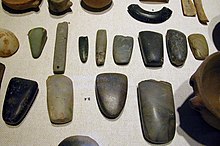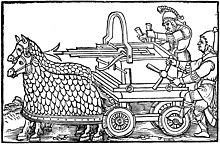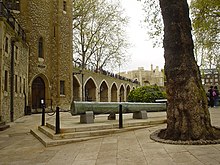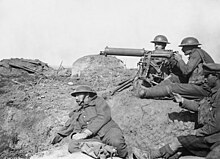Weapon

| Part of a series on |
| War (outline) |
|---|
 |
Aweapon,arm,orarmamentis any implement or device that is used to deter, threaten, inflict physical damage, harm, orkill.Weapons are used to increase the efficacy and efficiency of activities such ashunting,crime(e.g.,murder),law enforcement,self-defense,warfare,orsuicide.In a broader context, weapons may be construed to include anything used to gain a tactical, strategic, material, or mental advantage over an adversary or enemy target.
While ordinary objects such assticks,rocks,bottles,chairs,andvehiclescan beused as weapons,many objects are expressly designed for the purpose; these range from simple implements such asclubs,axes,spears,andswordsto complicated modernfirearms,tanks,intercontinental ballistic missiles,biological weapons,andcyberweapons.Something that has been repurposed, converted, or enhanced to become a weapon of war is termedweaponized,such as aweaponized virusorweaponized laser.
History
[edit]The use of weapons has been a major driver ofcultural evolutionandhuman historyup to today since weapons are a type of tool that is used to dominate and subdue autonomous agents such as animals and, by doing so, allow for an expansion of the cultural niche, while simultaneously other weapon users (i.e., agents such as humans, groups, and cultures) are able to adapt to the weapons of enemies by learning, triggering a continuous process of competitive technological, skill, and cognitive improvement (arms race).[1]
Prehistoric
[edit]
The use of objects as weapons has been observed amongchimpanzees,[2]leading to speculation that earlyhominidsused weapons as early as five million years ago.[3]However, this cannot be confirmed using physical evidence because wooden clubs, spears, and unshaped stones would have left an ambiguous record. The earliest unambiguous weapons to be found are theSchöningen spears,eight wooden throwing spears dating back more than 300,000 years.[4][5][6][7][8]At the site of Nataruk in Turkana, Kenya, numerous human skeletons dating to 10,000 years ago may present evidence of traumatic injuries to the head, neck, ribs, knees, and hands, includingobsidianprojectiles embedded in the bones that might have been caused by arrows and clubs during conflict between two hunter-gatherer groups.[9]But the interpretation of warfare at Nataruk has been challenged due to conflicting evidence.[10]
Ancient history
[edit]
The earliestancient weaponswere evolutionary improvements of lateNeolithicimplements, but significant improvements in materials and crafting techniques led to a series of revolutions inmilitary technology.
The development of metal tools began withcopperduring theCopper Age(about 3,300 BC) and was followed by theBronze Age,leading to the creation of theBronze Age swordand similar weapons.
During the Bronze Age, the first defensive structures andfortificationsappeared as well,[11]indicating an increased need for security. Weapons designed to breach fortifications followed soon after, such as thebattering ram,which was in use by 2500 BC.[11]
The development ofironworkingaround 1300 BC in Greece had an important impact on the development of ancient weapons. It was not the introduction of earlyIron Age swords,however, as they were not superior to their bronze predecessors, but rather thedomestication of the horseand widespread use ofspokedwheels byc. 2000 BC.[12]This led to the creation of the light, horse-drawnchariot,whose improved mobility proved important during this era.[13]Spoke-wheeled chariot usage peaked around 1300 BC and then declined, ceasing to be militarily relevant by the 4th century BC.[14]
Cavalrydeveloped once horses were bred to support the weight of a human.[15]The horse extended the range and increased the speed of attacks. Alexander's conquest saw the increased use of spears and shields in the Middle East and Western Asia as a result Greek culture spread which saw many Greek and other European weapons be used in these regions and as a result many of these weapons were adapted to fit there new use in war
In addition to land-based weaponry,warships,such as thetrireme,were in use by the 7th century BC.[16] During the firstFirst Punic War,the use of advanced warships contributed to a Roman victory over the Carthaginians.
Post-classical history
[edit]This sectionneeds additional citations forverification.(December 2021) |

European warfare duringpost-classical historywas dominated by elite groups ofknightssupported by massedinfantry(both in combat and ranged roles). They were involved in mobile combat andsieges,which involved varioussiege weaponsand tactics. Knights on horseback developed tactics for charging withlances,providing an impact on the enemy formations, and then drawing more practical weapons (such asswords) once they entered melee. By contrast, infantry, in the age before structured formations, relied on cheap, sturdy weapons such asspearsand billhooks in close combat andbowsfrom a distance. As armies became more professional, their equipment was standardized, and infantry transitioned topikes.Pikes are normally seven to eight feet in length and used in conjunction with smaller sidearms (short swords).

In Eastern andMiddle Easternwarfare, similar tactics were developed independent of European influences.
The introduction ofgunpowderfrom Asia at the end of this period revolutionized warfare. Formations ofmusketeers,protected bypikemen,came to dominate open battles, and thecannonreplaced thetrebuchetas the dominantsiege weapon. The Ottoman used the cannon to destroy much of the fortifications at Constantinople which would change warfare as gunpowder became more available and technology improved
Modern history
[edit]This sectionneeds additional citations forverification.(December 2021) |
Early modern
[edit]The EuropeanRenaissancemarked the beginning of the implementation of firearms in western warfare.Gunsandrocketswere introduced to the battlefield.
Firearmsare qualitatively different from earlier weapons because they release energy from combustiblepropellants,such asgunpowder,rather than from a counterweight or spring. This energy is released very rapidly and can be replicated without much effort by the user. Therefore, even early firearms such as thearquebuswere much more powerful than human-powered weapons. Firearms became increasingly important and effective during the 16th–19th centuries, with progressive improvements inignition mechanismsfollowed by revolutionary changes inammunitionhandling and propellant. During theAmerican Civil War,new applications of firearms, including themachine gunandironclad warship,emerged that would still be recognizable and useful military weapons today, particularly inlimited conflicts.In the 19th century,warshippropulsion changed fromsailpower tofossil fuel-poweredsteam engines.

Since the mid-18th century North American French-Indian war through the beginning of the 20th century, human-powered weapons were reduced from the primary weaponry of the battlefield to yielding gunpowder-based weaponry. Sometimes referred to as the "Age of Rifles",[17]this period was characterized by the development of firearms for infantry and cannons for support, as well as the beginnings of mechanized weapons such as themachine gun.Artillery pieces such ashowitzerswere able to destroy masonry fortresses and other fortifications, and this single invention caused arevolution in military affairs,establishing tactics and doctrine that are still in use today.
World War I
[edit]
An important feature ofindustrial agewarfare wastechnological escalation– innovations were rapidly matched through replication or countered by another innovation.
World War Imarked the entry of fully industrialized warfare as well asweapons of mass destruction(e.g.,chemicalandbiological weapons), and new weapons were developed quickly to meet wartime needs. Thetechnological escalation during World War Iwas profound, including the wide introduction ofaircraftintowarfareand naval warfare with the introduction ofaircraft carriers.Above all, it promised the military commanders independence from horses and a resurgence inmaneuver warfarethrough the extensive use of motor vehicles. The changes that these military technologies underwent were evolutionary but defined their development for the rest of the century.[This paragraph needs citation(s)]
Interwar
[edit]This period of innovation in weapon design continued in the interwar period (between WWI and WWII) with the continuous evolution of weapon systems by all major industrial powers. The major armament firms wereSchneider-Creusot(based in France),Škoda Works(Czechoslovakia), andVickers(Great Britain). The 1920s were committed to disarmament and the outlawing of war and poison gas, but rearmament picked up rapidly in the 1930s. The munitions makers responded nimbly to the rapidly shifting strategic and economic landscape. The main purchasers of munitions from the big three companies were Romania, Yugoslavia, Greece, and Turkey – and, to a lesser extent, Poland, Finland, the Baltic States, and the Soviet Union.[18]
Criminalizing poison gas
[edit]Realistic critics understood that war could not really be outlawed, but its worst excesses might be banned.Poison gasbecame the focus of a worldwide crusade in the 1920s. Poison gas did not win battles, and the generals did not want it. The soldiers hated it far more intensely than bullets or explosive shells. By 1918, chemical shells made up 35 percent of French ammunition supplies, 25 percent of British, and 20 percent of American stock. The “Protocol for the Prohibition of the Use in War of Asphyxiating, Poisonous, or Other Gases and of Bacteriological Methods of Warfare”, also known as theGeneva Protocol,was issued in 1925 and was accepted as policy by all major countries. In 1937, poison gas was manufactured in large quantities but not used except against nations that lacked modern weapons or gas masks.[19][20]
World War II and postwar
[edit]
Many modern military weapons, particularly ground-based ones, are relatively minor improvements to weapon systems developed during World War II. World War II marked perhaps the most frantic period of weapon development in the history of humanity. Massive numbers of new designs and concepts were fielded, and all existing technologies were improved between 1939 and 1945. The most powerful weapon invented during this period was thenuclear bomb;however, many other weapons influenced the world, such asjet aircraftandradar,but were overshadowed by the visibility of nuclear weapons and long-range rockets.[This paragraph needs citation(s)]
Nuclear weapons
[edit]Since the realization ofmutual assured destruction(MAD), the nuclear option of all-out war is no longer considered a survivable scenario. During theCold Warin the years following World War II, both the United States and the Soviet Union engaged in anuclear arms race.Each country and their allies continually attempted to out-develop each other in the field of nuclear armaments. Once the joint technological capabilities reached the point of being able to ensure the destruction of the Earth by 100 fold, a new tactic had to be developed. With this realization, armaments development funding shifted back to primarily sponsoring the development of conventional arms technologies for support oflimited warsrather thantotal war.[21]
Types
[edit]By user
[edit]- – what person or unit uses the weapon
- Personal weapons(orsmall arms) – designed to be used by a single person.
- Light weapons– 'man-portable' weapons that may require a small team to operate.[22]
- Heavy weapons –artilleryand similar weapons larger than light weapons (seeSALW).
- Crew served weapons– larger than personal weapons, requiring two or more people to operate correctly.
- Fortification weapons– mounted in a permanent installation or used primarily within a fortification.
- Mountain weapons– for use by mountain forces or those operating in difficult terrain.
- Vehicle weapons– to be mounted on any type ofcombat vehicle.
- Railway weapons– designed to be mounted on railway cars, including armored trains.
- Aircraft weapons– carried on and used by some type ofaircraft,helicopter,or other aerial vehicle.
- Naval weapons– mounted onshipsandsubmarines.
- Space weapons– are designed to be used in or launched from space.
- Autonomous weapons– are capable of accomplishing a mission with limited or no human intervention.
By function
[edit]- – the construction of the weapon and the principle of operation
- Antimatter weapons(theoretical) – would combine matter andantimatterto cause a powerful explosion.
- Archeryweapons – operate by using a tensioned string and a bent solid to launch a projectile.
- Artillery– firearms capable of launching heavy projectiles over long distances.
- Biological weapons– spread biological agents, causing disease or infection.
- Chemical weapons– poison people and cause reactions.
- Energy weapons– rely on concentrating forms of energy to attack, such as lasers or sonic attacks.
- Explosive weapons– use a physical explosion to create a blast, concussion, or spreadshrapnel.
- Firearms– use a chemical charge to launch projectiles.
- Improvised weapons– common objects reused as weapons, such as crowbars and kitchen knives.
- Incendiary weapons– cause damage by fire.
- Non-lethal weapons– designed to subdue without killing.
- Magnetic weapons– use magnetic fields to propel projectiles or focus particle beams.
- Melee weapons– operate as physical extensions of the user's body and directly impact a close target.
- Blade weapons– designed to pierce or cut through skin, muscle, or bone and cause internal or external bleeding.
- Blunt instruments– designed to break or fracture bones, produceconcussions,create organ ruptures, orcrush injuries.
- Missiles– rockets that are guided to their target after launch. (Also a general term forprojectileweapons.)
- Loitering munitions– designed toloiterover a battlefield, striking once a target is located.
- Nuclear weapons– use radioactive materials to createnuclear fissionornuclear fusiondetonations
- Ranged weapons– (unlikemelee weapons) target a distant object or person.
- Rockets– self-propelled projectiles.
- Suicide weapons– exploit the willingness of their operators not surviving the attack.
By target
[edit]- – the type of target the weapon is designed to attack
- Anti-aircraftweapons – target missiles and aerial vehicles in flight.
- Anti-fortification weapons– designed to target enemy installations.
- Anti-personnel weapons– designed to attack people, either individually or in numbers.
- Anti-radiationweapons – target sources of electronic radiation, particularly radar emitters.
- Anti-satellite weapons– target orbiting satellites.
- Anti-ship weapons– target ships and vessels on water.
- Anti-submarine weapons– target submarines and other underwater targets.
- Anti-tank weapons– designed to defeat armored targets.
- Area denial weapons– target territory, making it unsafe or unsuitable for enemy use or travel.
- Hunting weapons– weapons used to huntgame animals.
- Infantry support weapons– designed to attack various threats to infantry units.
- Siege engines– designed to break or circumvent heavy fortifications insiege warfare.
Manufacture of weapons
[edit]
The arms industry is a global industry that involves the sale and manufacture of weaponry. It consists of acommercialindustryinvolved in theresearch and development,engineering,production, and servicing ofmilitarymaterial, equipment, and facilities. Manyindustrialized countrieshave a domestic arms industry to supply their own military forces, and some also have a substantial trade in weapons for use by their citizens for self-defense, hunting, or sporting purposes.
Contracts to supply a given country's military are awarded by governments, making arms contracts of substantial political importance. The link between politics and the arms trade can result in the development of a "military–industrial complex",where the armed forces, commerce, and politics become closely linked.
According to research institute SIPRI, the volume of international transfers of major weapons in 2010–2014 was 16 percent higher than in 2005–2009,[23]and the arms sales of the world's 100 largest private arms-producing and military services companies totaled $420 billion in 2018.[24]
Legislation
[edit]The production, possession, trade, and use of many weapons are controlled. This may be at alocalorcentral governmentlevel or by international treaty. Examples of such controls include:
Gun laws
[edit]All countries have laws and policies regulating aspects such as the manufacture, sale, transfer, possession, modification, and use of small arms by civilians.
Countries that regulate access to firearms will typically restrict access to certain categories of firearms and then restrict the categories of persons who may be granted a license for access to such firearms. There may be separate licenses for hunting, sport shooting (a.k.a. target shooting), self-defense, collecting, and concealed carry, with different sets of requirements, permissions, and responsibilities.
Arms control laws
[edit]International treaties and agreements place restrictions on the development, production, stockpiling, proliferation, and usage of weapons, fromsmall armsandheavy weaponstoweapons of mass destruction.Arms control is typically exercised through the use of diplomacy, which seeks to impose such limitations upon consenting participants, although it may also comprise efforts by a nation or group of nations to enforce limitations upon a non-consenting country.
Arms trafficking laws
[edit]This sectionneeds expansion.You can help byadding to it.(May 2018) |
Arms trafficking is the trafficking of contraband weapons andammunition.What constitutes legal trade in firearms varies widely, depending on local and national laws. In 2001, theUnited Nationshad made aprotocolagainst the manufacturing and trafficking of illicit arms. This protocol made governments dispose illegal arms, and to licence new firearms being produced, to ensure them being legitimate.[25]It was signed by 122 parties.
Lifecycle problems
[edit]There are a number of issues around the potential ongoing risks from deployed weapons, the safe storage of weapons, and their eventual disposal when they are no longer effective or safe.
- Ocean dumpingof unused weapons such as bombs, ordnance, landmines, and chemical weapons has been common practice by many nations and has created hazards.[26][27][28][29]
- Unexploded ordnance(UXO) are bombs, land mines, naval mines, and similar devices that did not explode when they were employed and still pose a risk for many years or decades.
- Deminingor mine clearance from areas of past conflict is a difficult process, but every year, landmines kill 15,000 to 20,000 people and severely maim countless more.[30]
- Nuclear terrorismwas a serious concern after the fall of theSoviet Union,with the prospect of "loose nukes" being available.[31]While this risk may have receded,[32]similar situations may arise in the future.
In science fiction
[edit]Strange and exotic weapons are a recurring feature or theme inscience fiction.In some cases, weapons first introduced in science fiction have now become a reality. Other science fiction weapons, such asforce fieldsandstasis fields,remain purely fictional and are often beyond the realms of known physical possibility.
At its most prosaic, science fiction features an endless variety ofsidearms,mostly variations on real weapons such asgunsandswords.Among the best-known of these are thephaserused in theStar Trektelevision series, films, and novels, and thelightsaberandblasterfeatured in theStar Warsmovies, comics, novels, and TV series.
In addition to adding action and entertainment value, weaponry in science fiction sometimes becomes a theme when it touches on deeper concerns, often motivated by contemporary issues. One example is science fiction that deals withweapons of mass destructionlikedoomsday devices.
See also
[edit]References
[edit]- ^Löffler, D.; McGraw, J.J.; Johannsen, N.N. (2016)."Weapons in and as history. On the ontogenerative function of materialized preemption and intelligence in weapons technology".Identities.16(1–2): 68–77.
- ^Pruetz, J.D.; Bertolani, P. (2007)."Savanna Chimpanzees, Pan troglodytes verus, Hunt with Tools".Current Biology.17(5): 412–417.Bibcode:2007CBio...17..412P.doi:10.1016/j.cub.2006.12.042.PMID17320393.S2CID16551874.
- ^Weiss, Rick (February 22, 2007)"Chimps Observed Making Their Own Weapons",The Washington Post
- ^Thieme, Hartmut and Maier, Reinhard (eds.) (1995)Archäologische Ausgrabungen im Braunkohlentagebau Schöningen.Landkreis Helmstedt, Hannover.
- ^Thieme, Hartmut (2005). "Die ältesten Speere der Welt – Fundplätze der frühen Altsteinzeit im Tagebau Schöningen".Archäologisches Nachrichtenblatt.10:409–17.
- ^Baales, Michael; Jöris, Olaf (2003). "Zur Altersstellung der Schöninger Speere".Erkenntnisjäger: Kultur und Umwelt des Frühen Menschen Veröffentlichungen des Landesamtes für Archäologie Sachsen-Anhalt.57:281–88.
- ^Jöris, O. (2005) "Aus einer anderen Welt – Europa zur Zeit des Neandertalers". In: N.J. Conardet al.(eds.):Vom Neandertaler zum modernen Menschen.Ausstellungskatalog Blaubeuren. pp. 47–70.
- ^Thieme, H. (1997). "Lower Palaeolithic hunting spears from Germany".Nature.385(6619): 807–10.Bibcode:1997Natur.385..807T.doi:10.1038/385807a0.PMID9039910.S2CID4283393.
- ^Lahr, M. Mirazón; Rivera, F.; Power, R.K.; Mounier, A.; Copsey, B.; Crivellaro, F.; Edung, J.E.; Fernandez, J.M. Maillo; Kiarie, C. (2016)."Inter-group violence among early Holocene hunter-gatherers of West Turkana, Kenya".Nature.529(7586): 394–398.Bibcode:2016Natur.529..394L.doi:10.1038/nature16477.PMID26791728.S2CID4462435.
- ^Stojanowski, Christopher M.; Seidel, Andrew C.; Fulginiti, Laura C.; Johnson, Kent M.; Buikstra, Jane E. (2016). "Contesting the massacre at Nataruk".Nature.539(7630): E8–E10.doi:10.1038/nature19778.PMID27882979.S2CID205250945.
- ^abGabriel, Richard A.; Metz, Karen S."A Short History of War".au.af.mil.Retrieved2010-01-08.
- ^Wheel and Axle Summary.BookRags. 2010.Retrieved2011-06-13.
- ^"History Of The Horse-drawn Carriage".cookscarriages.Retrieved2024-02-29.
- ^"Science Show: The Horse in History".abc.net.au. 1999-11-13.Retrieved2011-06-13.
- ^Keegan, John (1993).A History of Warfare.Pimlico.ISBN978-0-7126-9850-4.
- ^"The Trireme (1/2)".Mlahanas.de. Archived fromthe originalon 2011-06-19.Retrieved2011-06-13.
- ^Hind, Edward (1860).My Magazine. Being a Series of Poems, Tales, Sketches, Essays, Orations, Etc.Nottingham: J. and H. Clarke. p. 263.
- ^Jonathan A. Grant,Between Depression and Disarmament: The International Armaments Business, 1919–1939(Cambridge UP, 2018).Online review
- ^Eric Croddy; James J. Wirtz (2005).Weapons of Mass Destruction: An Encyclopedia of Worldwide Policy, Technology, and History.ABC-CLIO. p. 140.ISBN9781851094905.
- ^Tim Cook, "'Against God-Inspired Conscience': The Perception of Gas Warfare as a Weapon of Mass Destruction, 1915–1939."War & Society18.1 (2000): 47–69.
- ^Estabrooks, Sarah (2004)."Funding for new nuclear weapons programs eliminated".The Ploughshares Monitor.25(4). Archived fromthe originalon June 20, 2007.
- ^"1997 Report of the Panel of Governmental Experts on Small Arms".un.org.27 August 1997.Retrieved6 August2012.
- ^Global Arms Industry: US Companies Dominate Top 100 Arm IndustrySIPRI. Retrieved 2019-12-18.
- ^The SIPRI Top 100 Arms-Producing and Military Service Companies 2018SIPRI. Retrieved 2019-12-18.
- ^"The Firearms Protocol".United Nations: Office on Drugs and Crime.Retrieved2024-08-09.
- ^Wilkinson, Ian (August 2017)."Chemical Weapon Munitions Dumped at Sea: An Interactive Map".James Martin Center for Nonproliferation Studies.Retrieved19 August2017.
- ^Curry, Andrew."Chemical Weapons Dumped in the Ocean After World War II Could Threaten Waters Worldwide".SMITHSONIAN.COM.Retrieved19 August2017.
- ^"Military Ordinance [sic] Dumped in Gulf of Mexico".Maritime Executive.August 3, 2015.Retrieved4 August2015.
- ^Edgar B. Herwick III (29 July 2015)."Explosive Beach Objects – Just Another Example Of Massachusetts' Charm".WGBH news.PBS.Retrieved4 August2015.
- ^"Demining".UN.Retrieved19 August2017.
- ^"Russia: Threat Of Unsecured Weapons Considered Serious".3 October 1997.
- ^Allison, Graham (December 29, 2011)."Washington Can Work: Celebrating Twenty Years With Zero Nuclear Terrorism".The Huffington Post.RetrievedJuly 26,2012.
